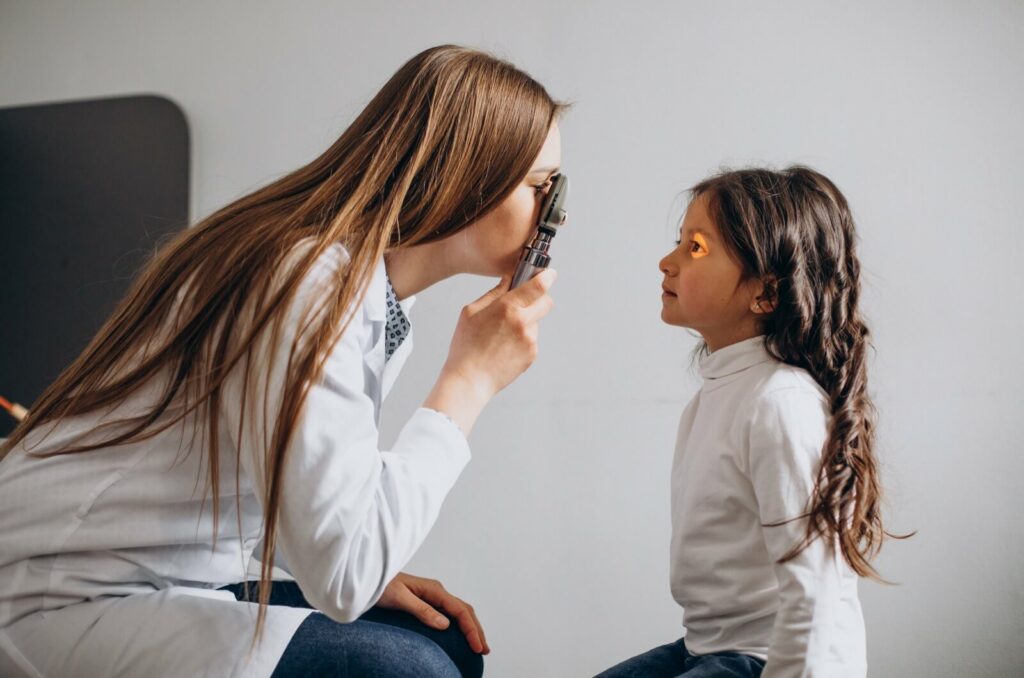Is your child struggling to see the whiteboard at school? Do they sit extremely close to the TV or hold books near their face when reading? These could be signs of a refractive error called myopia, commonly known as nearsightedness.
Childhood myopia is increasing at an alarming rate worldwide, with more children developing the condition at younger ages than ever before. With our increasingly digital lifestyle and reduced outdoor time, this trend is expected to continue.
There are several effective strategies to slow myopia progression in children, including increased outdoor time, specialized eyewear like myopia control glasses and contact lenses, low-dose atropine eye drops, proper visual habits, and regular comprehensive eye exams.
Understanding Childhood Myopia
Myopia occurs when the eyeball grows too long or the cornea curves too steeply, causing light to focus in front of the retina rather than directly on it. The result is clear vision for near objects but blurry vision for distant objects.
In children, myopia typically begins between ages 6 and 14 and can progress rapidly into the teenage years. While genetics plays a significant role in myopia development, environmental factors such as reduced outdoor time and increased near work (like reading and screen use) also contribute substantially.
Why Managing Myopia Progression Matters
Childhood myopia isn’t just about needing stronger glasses each year. When left to progress unchecked, high myopia significantly increases the risk of serious eye conditions later in life, including:
- Retinal detachment
- Myopic macular degeneration
- Glaucoma
- Cataracts
- Permanent vision loss
By taking steps to slow myopia progression during childhood, we can help reduce these risks and preserve better lifelong vision for our children.
Effective Strategies to Slow Myopia Progression
1. Increase Outdoor Time
One of the most effective and natural ways to slow myopia progression is encouraging children to spend more time outdoors in natural light.
Research shows that children who spend at least 90-120 minutes outdoors each day have a significantly lower risk of myopia progression. Natural sunlight triggers the release of dopamine in the retina, which helps regulate eye growth and prevent the eyeball from elongating too quickly.
Try these approaches to increase your child’s outdoor time:
- Schedule outdoor playtime after school before homework begins
- Participate in outdoor sports or activities on weekends
- Take family walks after dinner
- Choose outdoor settings for birthday parties and playdates
2. Specialized Eyewear for Myopia Control
Myopia Control Eyeglasses
Traditional glasses correct vision but don’t slow myopia progression. However, specialized myopia control glasses can help manage the condition:
- Peripheral defocus glasses: These lenses correct central vision while creating a peripheral defocus that signals the eye to slow its growth.
- MiYOSMART lenses: These lenses use D.I.M.S. (Defocus Incorporated Multiple Segments) technology to slow myopia progression while providing clear vision.
Specialty Contact Lenses
Several types of contact lenses have proven effective for myopia management:
- Orthokeratology or Ortho-K: These vision retainer rigid gas-permeable contact lenses gently reshape the front surface of the eye (cornea) overnight. Similar to how dental retainers realign teeth, these lenses help correct vision and slow myopia progression.
- MiSight 1 day lenses: We proudly offer these CooperVision dual-vision soft contact lenses, which work similarly to how bifocals inhibit myopia progression. These daily disposable lenses are specifically designed for children and are FDA-approved for myopia control.
At Signature Eye Care, we offer comprehensive contact lens exams and fittings to determine the best option for your child’s needs.
3. Healthy Visual Habits
Developing good visual habits can help reduce unnecessary eye strain and may complement other myopia control strategies:
- Follow the 20-20-20 rule: When doing near work or using digital devices, take a break every 20 minutes to look at something 20 feet away for at least 20 seconds.
- Maintain proper reading distance: Encourage your child to hold books and devices at least 12-16 inches (30-40 cm) away from their eyes.
- Ensure good lighting: Provide adequate lighting for reading and close work to reduce eye strain.
- Limit continuous near work: Break up long periods of reading or screen time with physical activity or distant viewing.
4. Regular Comprehensive Eye Exams
Early detection and intervention are crucial for effective myopia management. Regular comprehensive eye exams help monitor vision changes and allow for timely adjustments to treatment plans.
Children should have their first eye exam at 6 months of age, another at age 3, and again before starting school. After that, children should have annual eye exams, or more frequently if they have existing vision problems or risk factors.
Myopia Management at Signature Eye Care
At Signature Eye Care, we take a personalized approach to myopia management. Our comprehensive program includes:
- Thorough assessment: We conduct detailed measurements of your child’s vision, eye health, and risk factors.
- Customized treatment plan: Based on your child’s needs, we recommend the most appropriate combination of interventions.
- Regular monitoring: We track your child’s progress and make adjustments as needed to optimize results.
- Parent and child education: We provide guidance on implementing strategies at home to complement in-office treatments.

Take Action Today for Your Child’s Vision Future
Myopia progression doesn’t have to be inevitable. With early intervention and consistent management, we can significantly slow its progression and reduce your child’s risk of serious eye conditions later in life.
If your child has been diagnosed with myopia or if you’ve noticed signs of nearsightedness, don’t wait to take action. Book an appointment with our team at Signature Eye Care today to explore our myopia management solutions. We’ll thoroughly evaluate your child’s situation and recommend the most appropriate treatment strategy.
Investing in myopia management now is an investment in your child’s lifelong visual health and quality of life.



